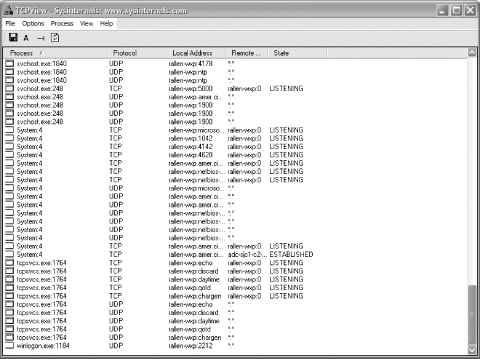Recipe10.9.Viewing the Open Ports and Connections
Recipe 10.9. Viewing the Open Ports and ConnectionsProblemYou want to view the open ports and connections on a server. SolutionUsing a graphical user interfaceThe Sysinternals TCPView tool is a graphical interface that displays all of the active connections on a host. It displays all of the connection information you might need, including process name and ID, protocol, local address and port, and remote address and port. It is a real-time tool, so it shows connections that are terminating in red and new connections in green. You can close a connection by right-clicking it and selecting Close Connection. You can also kill the associated process by selecting End Process. See Figure 10-1 for a screenshot of TCPView. Figure 10-1. Sysinternals TCPView Using a command-line interfaceThe netstat command displays all established connections on a host: > netstat Use the -a option to view all open ports regardless of whether they are active. With the Windows Server 2003 version of netstat, you can view the process ID associated with connections by specifying the -o option. The Sysinternals netstatp utility is the command-line version of TCPView. It displays similar information to netstat, but it shows the process name and ID associated with the connection by default: > netstatp Using VBScript' This code produces output very similar to the 'netstat -an' command. ' It requires that the target machine have SNMP and the WMI SNMP ' Provider installed. ' ------ SCRIPT CONFIGURATION ------ strComputerIP = "127.0.0.1" ' ------ END CONFIGURATION --------- set objLocator = CreateObject("WbemScripting.SWbemLocator") set objWMI = objLocator.ConnectServer("", "root/snmp/localhost") set objNamedValueSet = CreateObject("WbemScripting.SWbemNamedValueSet") objNamedValueSet.Add "AgentAddress", strComputerIP objNamedValueSet.Add "AgentReadCommunityName", "public" objNamedValueSet.Add "AgentWriteCommunityName", "public" WScript.Echo " Proto Local Address Foreign Address State" set colTCPConns = objWMI.Instancesof("SNMP_RFC1213_MIB_tcpConnTable",, _ objNamedValueSet ) for each objConn in colTCPConns WScript.echo " TCP " & objConn.tcpConnLocalAddress & ":" & _ objConn.tcpConnLocalPort & _ " " & objConn.tcpConnRemAddress & ":" & _ objConn.tcpConnRemPort & " " & objConn.tcpConnState next set colUDPConns = objWMI.Instancesof("SNMP_RFC1213_MIB_udpTable",, _ objNamedValueSet ) for each objConn in colUDPConns WScript.echo " UDP " & objConn.udpLocalAddress & ":" & _ objConn.udpLocalPort & " *:*" nextDiscussionWhen you take a look at the list of open connections on a server, you may be surprised to see so many. Unless the server is extremely busy, most should be in the LISTENING state, which simply means the port is open and waiting for a connection. For more on the various states that a connection may be in, see MS KB 137984. See AlsoMS KB 137984 (TCP Connection States and Netstat Output) and MS KB 281336 (How to determine which program uses or blocks specific transmission control protocol ports in Windows) |
EAN: 2147483647
Pages: 380